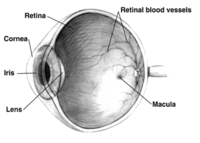
Photo from wikipedia
NADPH oxidase 4 (Nox4) is a major source of reactive oxygen species (ROS) in retinal endothelial cells (ECs) and is upregulated under hyperglycemic and hypoxic conditions. However, the role of… Click to show full abstract
NADPH oxidase 4 (Nox4) is a major source of reactive oxygen species (ROS) in retinal endothelial cells (ECs) and is upregulated under hyperglycemic and hypoxic conditions. However, the role of endothelial Nox4 upregulation in long-term retinal blood vessel damage in diabetic retinopathy (DR) remains undefined. Here, we attempted to address this question using humanized EC-specific Nox4 transgenic (hNox4EC-Tg) and EC-specific Nox4 knockout (Nox4EC-KO) mouse models. Our results show that, hNox4EC-Tg mice at age of 10-12 months exhibited increased tortuosity of retinal blood vessels, focal vascular leakage, and acellular capillary formation. In vitro study revealed enhanced apoptosis in brain microvascular ECs (BMECs) derived from hNox4EC-Tg mice, concomitant with increased mitochondrial ROS, elevated lipid peroxidation, decreased mitochondrial membrane potential (ΔΨm), and reduced mitochondrial respiratory function. In contrast, EC-specific deletion of Nox4 decreased mitochondrial ROS generation, alleviated mitochondrial damage, reduced EC apoptosis, and protected the retina from acellular capillary formation and vascular hyperpermeability in a streptozotocin-induced diabetes mouse model. These findings suggest that sustained upregulation of Nox4 in the endothelium contributes to retinal vascular pathology in diabetes, at least in part, through impairing mitochondrial function. Normalization of Nox4 expression in ECs may provide a new approach for prevention of vascular injury in DR.
Journal Title: Diabetes
Year Published: 2022
Link to full text (if available)
Share on Social Media: Sign Up to like & get
recommendations!